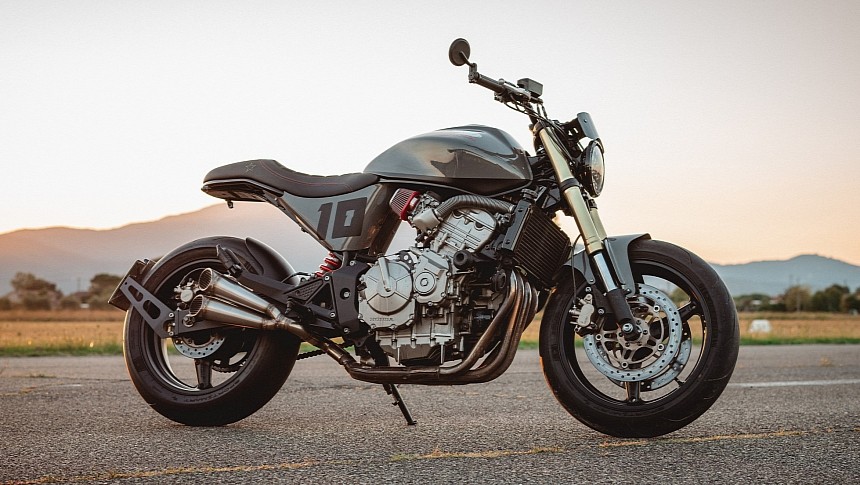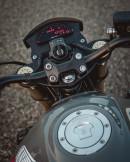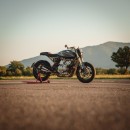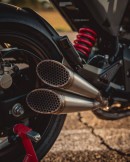Francis Von Tuto has been involved in the motorcycling industry since the year 2000, but his first encounter with customization took place in 2013. At the time, he owned a Harley-Davidson which had been caught up in a crash, and it was decided that it deserved a second chance at life in cafe racer form. After concluding this personal project in 2016, Francis figured he had what it takes to build custom bikes full-time.
The Italian craftsman came a long way since then, and what you’re seeing here is the latest machine he pieced together. In its previous incarnation, this thing used to be an incomplete Honda CB600F Hornet project bike from the model-year 2006. Before placing the motorcycle in Von Tuto’s capable hands, his client tried collaborating with a different workshop on this build.
However, the plan fell through for some unknown reason, so the Hornet had only been taken apart before making its way back to the owner. It was all up to Francis to take it from there, and one of the customer’s primary requests was for him to retain the stock fuel tank. Basing his design around this module, the Italian bike-modding guru started by modifying the donor’s rear-end proportions.
He did so with a new, loop-style rear section for the subframe, which shortens the CB600F’s geometry while leaving enough space for two-up riding. A fiberglass seat pan was subsequently placed up top, then finished off with high-density foam and black vinyl upholstery by BF Tappezzerie.
Flanking the custom saddle are triangular side covers, which conceal some relocated electronics and a lithium-ion battery. A bit further ahead, you’ll see a quartet of BMC pod filters ensuring ample airflow, and they’re complemented by fresh exhaust pipework. The factory headers were linked to a bespoke stainless-steel connector pipe and twin aftermarket mufflers.
In addition, Francis installed a Dynojet Stage 3 performance kit, as well, but we’re not told what power gains resulted from all this paraphernalia. Along with its gas tank and inline-four engine, the Hornet’s three-spoke wheels, brakes, and suspension items have also been retained.
Von Tuto performed an invigorating refurbishment on its inverted forks, while wrapping the hoops in grippy SportSmart TT rubber from Dunlop. There are handmade fenders fore and aft, made of aluminum and fiberglass, respectively. To keep the tail section looking as clean as possible, the project’s author fitted discreet LED lighting and a swingarm-mounted license plate bracket.
The way ahead is illuminated by a bright aftermarket headlamp, which sits right below a laser-cut nose fairing. Highsider turn signals are also present up north, while the cockpit bears a low-profile handlebar, Motogadget instrumentation, and bar-end mirrors. Lastly, the motorcycle’s paintwork is an understated mixture of grey and black, along with pinches of red on the Honda tank logos and various other items.
However, the plan fell through for some unknown reason, so the Hornet had only been taken apart before making its way back to the owner. It was all up to Francis to take it from there, and one of the customer’s primary requests was for him to retain the stock fuel tank. Basing his design around this module, the Italian bike-modding guru started by modifying the donor’s rear-end proportions.
He did so with a new, loop-style rear section for the subframe, which shortens the CB600F’s geometry while leaving enough space for two-up riding. A fiberglass seat pan was subsequently placed up top, then finished off with high-density foam and black vinyl upholstery by BF Tappezzerie.
Flanking the custom saddle are triangular side covers, which conceal some relocated electronics and a lithium-ion battery. A bit further ahead, you’ll see a quartet of BMC pod filters ensuring ample airflow, and they’re complemented by fresh exhaust pipework. The factory headers were linked to a bespoke stainless-steel connector pipe and twin aftermarket mufflers.
In addition, Francis installed a Dynojet Stage 3 performance kit, as well, but we’re not told what power gains resulted from all this paraphernalia. Along with its gas tank and inline-four engine, the Hornet’s three-spoke wheels, brakes, and suspension items have also been retained.
Von Tuto performed an invigorating refurbishment on its inverted forks, while wrapping the hoops in grippy SportSmart TT rubber from Dunlop. There are handmade fenders fore and aft, made of aluminum and fiberglass, respectively. To keep the tail section looking as clean as possible, the project’s author fitted discreet LED lighting and a swingarm-mounted license plate bracket.
The way ahead is illuminated by a bright aftermarket headlamp, which sits right below a laser-cut nose fairing. Highsider turn signals are also present up north, while the cockpit bears a low-profile handlebar, Motogadget instrumentation, and bar-end mirrors. Lastly, the motorcycle’s paintwork is an understated mixture of grey and black, along with pinches of red on the Honda tank logos and various other items.








